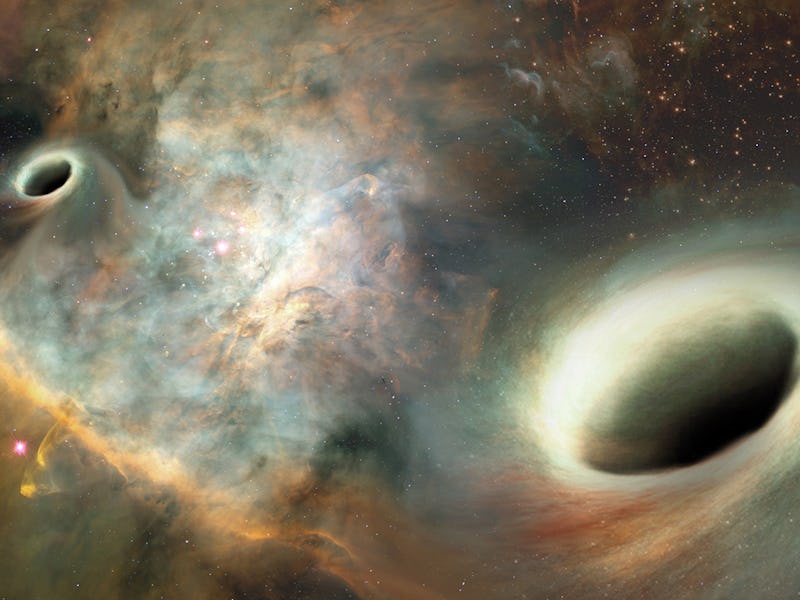Scientists Foresee the Milky Way’s Death in Orbiting Black Holes
Galactic collision is imminent.

The Milky Way is on a collision course with the Andromeda galaxy, and when the two colossal entities meet, they’ll shred each other apart.
What remains less certain, however, is what will happen to each of the galaxies’ black holes — those cryptic places in space where gravity’s pull is so powerful, not even light can escape. Now, for the first time, scientists have observed two “supermassive” black holes orbiting each other in a galaxy unfathomably far away from Earth — 750 million light-years — providing a clue to our own galaxy’s smashing fate. The observations were published this week in The Astrophysical Journal.
Inside this far-off galaxy, University of New Mexico scientists spotted two black holes and have been watching them closely for over a decade. They are huge, with a combined mass of 15 billion times our humble sun, and scientists estimate that it takes 24,000 years for these black masses to orbit one another. This presents a problem, because us Earthlings can’t possibly live long enough to glimpse the curving nature of their orbits.
“The best way to detect orbital motion is to be able to see the curvature, but we would have to live 4,000 years,” the study’s lead author and astrophysicist Karishma Bansal, tells Inverse. “The process itself is slow — maybe after 1,000 years, but I won’t be here so I won’t know.”
A false color image of the two massive black holes, as observed by the Very Large Array radio telescopes. Each black hole is surrounded by discs of orbiting matter, with jets of other matter shooting out atop and below.
Measuring this curvature would be like trying to discern the travels of a snail in another solar system. “If you imagine a snail on the recently-discovered Earth-like planet orbiting Proxima Centauri — 4.243 light years away — moving at 1 centimeter per second, that’s the angular motion we’re resolving here,” said Roger W. Romani, a physics professor at Stanford University.
Lacking immortality, Bansal and her team tried another tactic. She pinpointed the locations of both colossal galaxies, using a system of 10 radio telescopes placed across the U.S., collectively called the Very Long Baseline Array (VLBA), and over a period of 12 years they measured how one galaxy moved in relation to the other. The plotted changes in position suggest that the two black holes, forced together by a convergence of galaxies, are orbiting one another, though the shape of their orbits remains unknown.
Orbiting black holes are certainly intriguing, but scientists like Bansal wonder what happens next. The assumption is that these black holes will one day collide (a recurring theme in our universe), creating the rippling gravitational waves discovered in 2016 by a team of over 1,000 scientists, but there is no observable evidence of this collision occurring.
Finding a more compact binary galaxy system — with two black holes that don’t take 24,000 years to orbit one another — could give researchers a better look into the behaviors of these orbiting mega-masses, perhaps an instance of two black holes orbiting each other, or even fusing together, or absorbing one another in some twisted, cosmic union. “If we manage to find something closer, that would be huge,” says Basnal. “That would tell us what would happen. Their fate – it’s a mystery.”
An image from NASA's Chandra X-ray Observatory shows two galaxies colliding 140 million light-years from Earth.
And this will show us what fate has in store for our galaxy, the Milky Way, as it’s on course for a consequential meeting with the billion-star Andromeda, though in, perhaps, one billion years.
“They will rip one another apart, and the material around each other will merge,” explains Basnal. “Because they are both spiral galaxies, and are both so huge, they will distort the structure of one another.”
As for the black holes, it remains to be known, but scientists are peering into the cosmos to find out. “That’s what’s cool about astronomy,” she says. “You get to see something about our own future.”
Abstract: The radio galaxy 0402+379 is believed to host a supermassive black hole binary (SMBHB). The two compact-core sources are separated by a projected distance of 7.3 pc, making it the most (spatially) compact resolved SMBHB known. We present new multi-frequency VLBI observations of 0402+379 at 5, 8, 15, and 22 GHz and combine them with previous observations spanning 12 years. A strong frequency-dependent core shift is evident, which we use to infer magnetic fields near the jet base. After correcting for these shifts we detect significant relative motion of the two cores at at . With some assumptions about the orbit, we use this measurement to constrain the orbital period yr and SMBHB mass . While additional observations are needed to confirm this motion and obtain a precise orbit, this is apparently the first black hole system resolved as a visual binary.